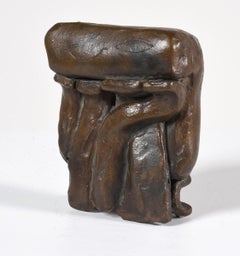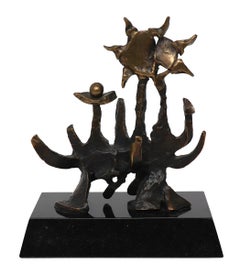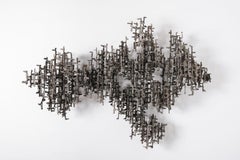Eugene Caples Art
to
2
Overall Width
to
Overall Height
to
2
2
2
2
2
10,138
2,779
1,375
1,369
2
Artist: Eugene Caples
Eugene Caples "Bronze Sculpture I" Abstract Bronze Sculpture
By Eugene Caples
Located in Detroit, MI
This small exquisite "Bronze Sculpture I" is in excellent condition and a perfect example of Eugene Caples craftsmanship. Although it is mainly abstract, there are bits that look figurative either an arm or a leg attempting to emerge from a fold or attempting to hold a pose such as in yoga. It cries out to be touched and held, looked at and caressed. The beautiful patina on the surface gives voice to the many hands that have done these things.
Eugene Caples is a designer and craftsman who worked in Kansas City in the 1960s and later through the early 21st century. He attended the Kansas City Art Institute, earning his Bachelors of Fine Arts in Industrial Design in 1959. In 1963 he was accepted to Cranbrook Academy of Art, Bloomfield Hills, Michigan. The Cranbrook Academy of Art was designed by architect and faculty member, Eliel Saarinen who collaborated with Charles and Ray Eames on chair and furniture design. Numerous creative artists are alumni of Cranbrook and include: Harry Bertoia, Florence Knoll, Jack Lenor Larsen, Donald Lipski, Duane Hanson, Nick Cave, Hani Rashid, George Nelson, Urban Jupena (Nationally recognized fiber artist), Artis Lane (the first African-American artist to have her sculpture, "Sojourner Truth," commissioned for the Emancipation Hall in the Capital Visitor Center in Washington DC), Cory Puhlman (televised Pastry Chef extraordinaire), Thom O’Connor (Lithographs), and Paul Evans (Created Brutalist-inspired sculpted metal furnishings.)
Gene worked...
Category
Late 20th Century American Modern Eugene Caples Art
Materials
Bronze
Eugene Caples "Bronze Sculpture II" Abstract Bronze Sculpture
By Eugene Caples
Located in Detroit, MI
This small exquisite "Bronze Sculpture II" is in excellent condition and a perfect example of Eugene Caples craftsmanship. This is mainly abstract with some graphic or architectural elements and is so delightful that mythical creatures demand to be considered. It cries out to be touched and held, looked at and caressed. The beautiful patina on the surface gives voice to the many hands that have done these things.
Eugene Caples is a designer and craftsman who worked in Kansas City in the 1960s and later through the early 21st century. He attended the Kansas City Art Institute, earning his Bachelors of Fine Arts in Industrial Design in 1959. In 1963 he was accepted to Cranbrook Academy of Art, Bloomfield Hills, Michigan. The Cranbrook Academy of Art was designed by architect and faculty member, Eliel Saarinen who collaborated with Charles and Ray Eames on chair and furniture design. Numerous creative artists are alumni of Cranbrook and include: Harry Bertoia, Florence Knoll, Jack Lenor Larsen, Donald...
Category
Late 20th Century American Modern Eugene Caples Art
Materials
Bronze
Related Items
Modern Abstract Bronze Sculpture by Edward Chavez, Mounted on Granite Base
By Edward Arcenio Chavez
Located in Denver, CO
This captivating mid-20th-century abstract bronze sculpture by Edward (Eduardo) Arcenio Chavez (1917–1995) beautifully exemplifies his dynamic sculptural style. Cast in bronze and mo...
Category
20th Century American Modern Eugene Caples Art
Materials
Granite, Bronze
$4,250
H 6.25 in W 6 in D 2 in
Large Brutalist Welded Steel Wall Sculpture by Dan Gluck - 1970s
Located in Dallas, TX
A commanding example of Brutalist artistry, this large-scale wall-mounted sculpture by Dan Gluck is composed of intricately welded steel elements arranged in a dynamic abstract compo...
Category
Mid-20th Century American Modern Eugene Caples Art
Materials
Steel
$4,800
H 39 in W 55 in D 6 in
"Reclining Figure" Louise Nevelson, Modernist, Human Form, Abstracted Body
By Louise Nevelson
Located in New York, NY
Louise Nevelson
Reclining Figure, circa 1943
Tattistone
8 inches high x 21 inches wide x 9 inches deep
With base 10 inches high x 21 3/4 inches wide x 9 1/2 inches deep
Provenance
T...
Category
1940s American Modern Eugene Caples Art
Materials
Cast Stone
$30,000
H 8 in W 21 in D 8 in
Ted Egri Taos Modernist Judaica Cubist Bronze Sculpture Rabbi & Torah WPA Artist
Located in Surfside, FL
Ted Egri (American, 1913-2010)
Bronze sculpture
Rabbi
Signed Egri and numbered 4/30 on side.
Dimensions: 12"L x 8.5"H x 6.75" D
Born in New York city in 1913 to a Hungarian Jewish emigre family (both of his parents were born in Hungary), Egri was first exposed to music later dropping that for art. He studied with Howard Giles at the Master Institute of the Roerich Museum in New York where he was introduced to Oriental arts, Chinese and Japanese art forms, and later with Hans Hofmann. He worked for the Federal Arts Project, the WPA, making mural paintings and silkscreen prints as well as easel painting. Once WWII began, Egri signed up to serve as a map maker for the Navy, and was witness to some of the fiercest battles in the Pacific. As an artist, he painted many important depictions of his wartime experiences and these works have all be donated to the U.S. Naval Museum.
Already a practicing painter and instructor at the Kansas City Art Institute, Ted Egri came to Taos, New Mexico with his wife Kit in 1950 to continue his study of painting at Ribak's Taos Valley Art School on the GI Bill. Louis Ribak quickly introduced Egri to Eulalia Emetaz, the owner of La Galleria Escondida, who gave him his first one-person show in 1951.
A prolific and versatile artist, as well as arts organizer and advocate, Egri's contributions to underserved African American, Native American, Hispanic and women were honored by two Taos mayors, with no less than two Ted Egri days during his 50-year art career in Taos. Egri remained in Taos. He became widely known for his sculpture, influenced by cubism and painting, with his style ranging from abstract to realistic. Egri had incredible draftsmanship - charcoal, pencil, pastel, watercolor, oils, mixed media, pen and ink, acrylic, gouache Over time his work gradually shifted from its focus on human struggle to an exploration of natural elements and the changes that come about as a result of living in a physical environment like Taos. "The impact of the majestic Sangre de Cristo Mountain Range and the vast spaces of the mesas directed me toward space and form. I moved into sculpture," Egri said in a 1987 interview with ARTSPACE magazine. He was included in a show at Stables Gallery along with Emil Bisttram, Louis Catusco, Edward Corbett, Lawrence Calcagno, Keith Crown, Andrew Dasburg, John De...
Category
Mid-20th Century American Modern Eugene Caples Art
Materials
Bronze
$3,600
H 12 in W 8.5 in D 6.75 in
Granite Sail - Abstract Wall Sculpture in Wood, Resin, and Aluminum
Located in Soquel, CA
Granite Sail - Abstract Wall Sculpture in Wood, Resin, and Aluminum
Whimsical and fluid abstract composition by Craig French (American, b. 1959). Cast re...
Category
1990s American Modern Eugene Caples Art
Materials
Metal
$6,250
H 41 in W 65 in D 6 in
Milton Hebald Mid Century Bronze Menorah Sculpture WPA Artist Modernist Judaica
Located in Surfside, FL
Milton Hebald (American, 1917-2015)
Lion of Judah menorah
bronze on a white marble plinth base
signed in bronze
12" H x 10.5" W x 2.5" D
Milton Elting Hebald (1917 – 2015) was a s...
Category
1960s American Modern Eugene Caples Art
Materials
Marble, Bronze
$6,500
H 12 in W 10.5 in D 2.5 in
American Craft Studio Handmade Sculpture Welded Bronze Kinetic Vessel Op Art
Located in Surfside, FL
Great studio piece. It does not appear to be signed.
Welded bronze
an openwork vessel or vase
Verdigris patina, might be suitable for outdoors
Dimensions: 18 X 16 X 9 inches
Provena...
Category
20th Century American Modern Eugene Caples Art
Materials
Bronze
$1,500
H 18 in W 16 in D 9 in
"Zofar" Boaz Vaadia, Human Body, Bronze and Stone, Anthropomorphic Sculpture
By Boaz Vaadia
Located in New York, NY
Boaz Vaadia
Zofar, 1997
Bronze, bluestone, and boulder
Overall 20 x 29 x 27 inches
From the edition of 7
Provenance
Elaine Baker Gallery, Boca Raton, Florida
Boaz Vaadia is the in...
Category
1990s American Modern Eugene Caples Art
Materials
Stone, Bluestone, Bronze
$40,000
H 20 in W 29 in D 27 in
Cameo Pink Seaform with Black Lip Wrap (94.678.s1)
By Dale Chihuly
Located in Missouri, MO
Cameo Pink Seaform with Black Lip Wrap (94.678.s1), 1994
Dale Chihuly (American, b. 1941)
14 x 32 x 18 inches
Born in Tacoma, Washington, Dale Chihuly became the most famous ornate ...
Category
1990s American Modern Eugene Caples Art
Materials
Glass, Blown Glass
"Abstract Figure with Face" Louise Nevelson, American Female, Anthropomorphic
By Louise Nevelson
Located in New York, NY
Louise Nevelson
Abstract Figure with Face, circa 1945
Incised "LN" on the reverse
Tattistone
6 inches high x 14 inches wide x 5 1/4 inches deep
Provenance
The artist
The artist's ni...
Category
1940s American Modern Eugene Caples Art
Materials
Cast Stone
$24,000
H 6 in W 14 in D 5.25 in
Angelo Di Benedetto Mid-Century Abstract Metal Sculpture, Signed, Brutalist Art
By Angelo Di Benedetto
Located in Denver, CO
This striking mid-century modern abstract sculpture is a rare, original work by acclaimed American artist Angelo Di Benedetto (1913–1992). Crafted in industrial metal, the piece mast...
Category
20th Century American Modern Eugene Caples Art
Materials
Metal
$3,750
H 13.25 in W 11.25 in D 7.5 in
Zephyr Green Macchia with Blue Lip Wrap
By Dale Chihuly
Located in Missouri, MO
Zephyr Green Macchia with Blue Lip Wrap, 1996
Dale Chihuly (American, b. 1941)
8 x 10 x 10 inches
Signed and Dated on Bottom
Born in Tacoma, Washington, Dale Chihuly became the most...
Category
1990s American Modern Eugene Caples Art
Materials
Glass, Blown Glass
Eugene Caples art for sale on 1stDibs.
Find a wide variety of authentic Eugene Caples art available for sale on 1stDibs. You can also browse by medium to find art by Eugene Caples in bronze, metal and more. Much of the original work by this artist or collective was created during the 20th century and is mostly associated with the modern style. Not every interior allows for large Eugene Caples art, so small editions measuring 3 inches across are available. Eugene Caples art prices can differ depending upon medium, time period and other attributes. On 1stDibs, the price for these items starts at $1,950 and tops out at $1,950, while the average work can sell for $1,950.



